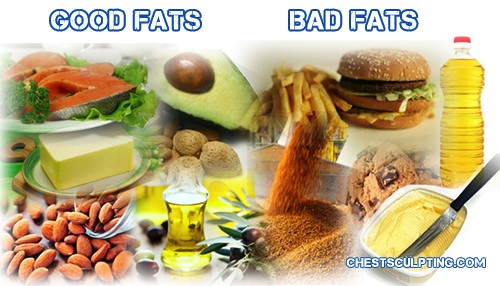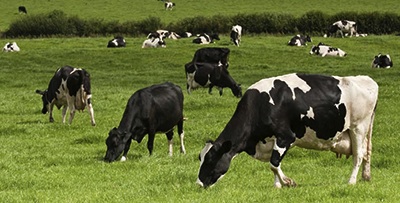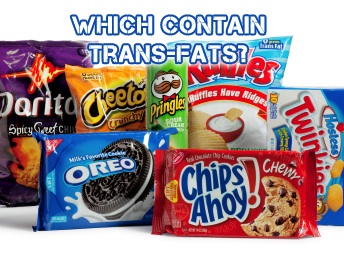Generally if you increase your fat intake and decrease your carb intake, regardless of what type of carb or fat, you will lose weight and your health will improve.
Remember the guy from ‘Fat Head' as discussed in this article, he ate a month's load of food cooked in the worst possible type of fat – trans-fats – and he still lost weight.
Though fats in general are better than carbs in general, let's not make the same mistake the government did back in the 1980s, when they labelled all fats as bad and all carbohydrates as good. Though the worst carbs are far worse than the worst fats, there are still a number of fats you should be avoiding.
Now it's easy to get confused when reading about the different types of fats. You've got saturated and unsaturated fats, omega-3s and omega-6s, polyunsaturated and monounsaturated, long-chain and short-chain fats, and so on. What I'll do is give you a quick primer on fats to help you get acquainted with the right types of fats for losing weight and improving your health.
A Primer on Fat
Fats are made up of building blocks called ‘fatty acids'. The properties of a fat, and whether it's healthy for you or not, depends on the chain-length of its fatty acids, and the degree of hydrogen saturation of its fatty acids.
There are three types of fat based on their degree of saturation with hydrogen: saturated, monounsaturated and polyunsaturated fats.
Vegetable oils and animal fats generally contain a mixture of these three types of fat. Olive oil for example, contains mostly monounsaturated fat with a small amount of polyunsaturated and saturated fat. Lard is roughly half saturated fat and half monounsaturated, with a small amount of polyunsaturated fat as well.
Though vegetables contain lots of good fats, vegetable oils are not the same.
Most vegetable oils are high in polyunsaturated fats (this is bad, I'll explain why in a bit), while most animal fats are high in saturated and monounsaturated fats (this is good). Examples of non-animal fats that contain high levels of either saturated or monounsaturated fats include palm, olive and coconut oil. All three are good for you.
Because your tissues are made up mostly of saturated and monounsaturated fats, your body needs more of these two types of fat than it needs polyunsaturated fats. Although your body does need polyunsaturated fats, it needs a relatively small amount.
One of the problems with the modern western diet is we eat far too many polyunsaturated fats, and it's reeking havoc in our bodies.
1. Saturated Fats (generally good)
As the name suggests, saturated fats are fully saturated with hydrogen. This allows them to be solid at room temperature. Examples include butter and coconut oil. More importantly, being fully saturated with hydrogens means they are the most stable of the fats, and tend not to go rancid, even when heated. Hence it's saturated fats you should be using for cooking, not polyunsaturated vegetable oils.
Conventional wisdom makes saturated fats out to be 100% evil and to be avoided at all costs. But as I mentioned earlier in this article, saturated fats lead to neither heart disease nor obesity, and the studies suggest they are actually good for your heart and help you to lose weight.
Good saturated fats you can use for cooking include butter, ghee, coconut oil and palm oil. Other good sources of saturated fats include high fat cheeses, fatty cuts of meat, full-fat cream, and nuts and seeds.
2. Monounsaturated Fats (generally good)
These are missing one pair of hydrogens, giving rise to a double-bond. The more double bonds a fatty acid has, the more fluid it is. Monounsaturated fats with their single double bond, are fluid at room temperature, and tend to be solid or semi-solid when refrigerated.
Examples of oils that contain monounsaturated fat include olive oil, sesame oil, sunflower oil, flaxseed oil, corn oil, safflower oil and peanut oil. Monounsaturated fats are also found in nuts and avocados.
Note that I say ‘contain' because as I mentioned earlier, most naturally occurring fats contain a mixture of different types of fat. As well as containing monounsaturated fat, the above oils also contain some level of polyunsaturated and saturated fats. Olive oil for example, contains around 75% monounsaturated fat while canola contains 60%.
Monounsaturated fats are good for you, but it's important to note that not all foods that contain monounsaturated fats are good for you. Corn oil for example, contains just 25% monounsaturated fats, and a whooping 55% of the bad form of polyunsaturated fats (i.e. omega-6 polyunsaturated fats).
3. Polyunsaturated Fats (PUFAs) (too much is bad)
PUFAs are missing more than one pair of hydrogen atoms, giving rise to more than one double bond. They tend to be liquid even when refrigerated.
PUFAs are very chemically unstable. They are prone to oxidation and go rancid easily, especially when they are heated.
These fats should never be used in cooking, because they get oxidized and wreak havoc in your body, leading to obesity, inflammation and a wide range of different inflammatory disorders.
And yet some of the most commonly used cooking oils are high in PUFAs. Examples include corn oil, soy oil, regular safflower and sunflower oils. Just because these oils are from vegetable sources, we assume they are healthy and good for us.
Polyunsaturated fats are also found in grains, soybeans and peanuts.
But to complicate things further, not all PUFAs are bad for you. Fish oils also contain PUFAs, but they contain a good form of PUFA. In the typical western diet, we not only consume too much PUFAs in general, we also consume too much of the wrong type of PUFAs.
Omega-3 VS Omega-6 PUFAs
You probably heard of omega-3 fats. Walk into any pharmacy or health store and you'll see a wide selection of different omega-3 supplements. Omega-3 is a good form of PUFA. It's found in fish, algae, plants and nuts, and it comes with numerous health benefits. It naturally thins your blood, helping to improve circulation and improve your heart health, it helps fight inflammation, supports brain function, and eases depression and anxiety. Studies have also shown that it helps significantly with weight loss.
Like omega-3s, omega-6 fats are also needed by your body in small quantities. But the problem is, the typical western diet contains far too many omega-6 fats compared with omega-3.
A high omega-6 to omega-3 ratio leads to inflammation, high blood pressure, depressed immune function, blood clots and sub-optimal brain function and development. Studies have also found a strong link of high dietary omega-6s to obesity.
Ideally, the ratio of omega-6 to omega-3 in your diet should be 1:1 (i.e. 50% omega-3 and 50% omega-6). But the average American today consumes as much as 30 parts omega-6 and 1 part omega-3 (i.e. a ratio of 30:1!).
This is largely because omega-6s are a lot more stable than omega-3s. Most forms of processing destroy omega-3 fats, leaving omega-6s intact. Where vegetables are naturally high in omega-3s, vegetable oils are high in omega-6 because the harsh chemical process used to extract these oils, ends up destroying the vegetable's naturally occurring omega-3 fats.
Grains and especially processed grains are high in omega-6 fats. Grains are mostly composed of carbs, which is bad enough, but they also contain bad fats, which adds insult to injury.
Breakfast cereals, a staple in the western diet, are processed grains that are high in omega-6 fats. You can expect all processed carbs to contain far more omega-6s than omega-3s, but that should be the least of your worries when it comes to processed carbs. When you're trying to lose man boobs, the carbohydrates in processed carbs and their effect on insulin is infinitely more damaging than the omega-6:3 ratio.
Grass-fed animals are higher in healthy Omega-3's than grain-fed animals.
It's important to note that animals that are fed grains as opposed to grass-fed animals, are known to have a high omega-6:3 ratio in their meat. Grain-fed chickens as opposed to chickens that are fed fish or flax meal, produce eggs that are much higher in omega-6.
When looking at the different oils, soybean oil has an omega ratio of 7:1, and corn oil has a ratio of 46:1. Olive oil has a ratio of 3:1, which isn't amazing, but it's not that big a deal with olive oil, since only about 11% of it is polyunsaturated to begin with. Corn oil is over 50% PUFA, so a ratio here of 46:1 is utterly devastating! Avoid this oil at all costs!
Trans-fats – a whole different breed of fats
Trans-fats used in processed foods are artificial fats that do not occur in nature. They are found in almost all processed foods, and in fried food prepared in fast-food outlets and restaurants. Examples include margarine, pastries, shortening, biscuits, donuts, cakes, pies, crackers, bread, popcorn, and typical fast food choices like fried chicken, burgers and french fries.
Almost all processed foods contain trans-fats
The use of trans-fats is extremely widespread because they are so convenient and cost-effective at the same time. This makes them perfect for commercial use.
See, the trouble with liquid oils is they are difficult to transport, can't be stored for long (they go rancid easy), and don't add quite the right texture to your food (imagine cookies dripping with oil instead of having their usual soft creamy texture bought about of course, by the use of trans-fats).
The trouble with natural saturated fats like coconut oil, butter and ghee, is they're too damn expensive!
So food manufacturers devised a solution. They decided to take the cheaper liquid unsaturated oils (usually vegetable oils), and try to saturate them using a chemical process (by adding hydrogen), so they'll be solid at room temperature. The result is a cheap, easily transportable, easily stored stable fat that doesn't go rancid, and when it comes to deep frying, can be used over and over again. When used in processed foods, trans-fats increase the storage life of products and can also enhance flavor and texture. So how can these food manufacturers resist using something so cost-effective and convenient?
The trouble however, is that the end result is not the same as a naturally occurring saturated fat. Trans-fats by definition, still have one or more double bonds. However, unlike in naturally occurring unsaturated fats, the double bonds in trans-fats have a trans configuration. Where normal fats are very supple and pliable, trans fatty acids are stiff. Since synthetic trans-fats don't occur in nature, your body doesn't know how to deal with them. As a result the trans fats you consume can build up in your body and wreak havoc
Indeed trans-fats are known to lead to aggressive fat gain, heart disease diabetes and a multitude of inflammatory disorders, cancer and various other diseases. Unlike with Other types of nutrient that are known to be bad for you, there is no safe upper limit for trans-fat consumption. Even the slightest amount of trans-fat consumption is bad for you and this type of fat should be completely avoided.
Remember though that when it comes to weight loss, refined carbs are much worse than trans-fats. Remember the program “Fat Head” I mentioned earlier? Tom Naughton goes on a fast-food diet that's no doubt laden with trans-fats. Despite this, he managed to still lose weight – 12 pounds in a single month. All because he cut out those nasty carbs. But one negative effect of the trans-fats in his diet was that his levels of good (HDL) cholesterol went down.
At the end of the program, Naughton details another experiment where he eats the same stuff as in the first experiment, but he cuts out the trans-fats and replaces them with healthy oils like coconut oil. In this experiment his lipid profile improved significantly. His bad (LDL) cholesterol dropped from 156 to 130, and his HDL increased from 49 to 64.
When you do your shopping, one tip to know how much trans-fat there is in a food is to read the ingredient label and look for “shortening”, “hydrogenated” or “partially hydrogenated oil”.
What More Can You Do Aside From Eating More Good Fats And Avoiding Bad Fats?
If all you did today was start avoiding bad fats and eating more good fats, it would do your health a LOT of good. But whether or not you lose your man boobs will depend on whether you are also making other lifestyle changes that are just as important. To find out more, please watch the following video on How To Lose Man Boobs Naturally:
https://chestsculpting.com/how-to-lose-man-boobs-naturally-free-video/







this article mention Peanut oil to contain Monounsaturated fats. Also, it mentioned that Polyunsaturated fats are found in Peanuts.
so is Peanut Butter allowed?
Hi Ahmed. No, the peanut is more of a legume than a nut. It’s also contaminated with aflatoxins and contains peanut agglutinin. You’re better off sticking to other nut butters, like almond butter and cashew butter.